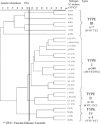Molecular epidemiology of Haemophilus influenzae type b causing vaccine failures in the United Kingdom
- PMID: 16672388
- PMCID: PMC1479165
- DOI: 10.1128/JCM.44.5.1645-1649.2006
Molecular epidemiology of Haemophilus influenzae type b causing vaccine failures in the United Kingdom
Abstract
Haemophilus influenzae type b (Hib) was a major cause of pediatric disease in the United Kingdom prior to the introduction of routine Hib immunization in 1992. An unexpected resurgence of cases of vaccine failure was observed with fully vaccinated children from 1999 onward. We investigated whether Hib isolates causing vaccine failures in the United Kingdom could have undergone a change in their population structure to elude the protective effect of Hib vaccine. Molecular epidemiology studies were carried out with 376 isolates from invasive infections (164 vaccine failures and 212 controls). Genetic variability was higher in controls than in vaccine failures. Of the four major clusters obtained, cluster I comprised 92.2% of the total isolates: 156 vaccine failures (95%) and 193 (91%) controls. Cluster IV was specific for vaccine failures but included only four isolates. The increased number of cases of invasive Hib in fully vaccinated children in the United Kingdom was caused by isolates belonging not to a particular or new genotype but to genotypes already circulating in the prevaccination era, before conjugate Hib vaccines were available.
Figures


References
-
- Bell, F., P. Heath, F. Shackley, N. Maclennan, and L. Diggle. 1998. Effect of combination with an acellular pertussis, diphtheria, tetanus vaccine on antibody response to Hib vaccine (PRP-T). Vaccine 16:637-642. - PubMed
-
- Chief Medical Officer, Chief Nursing Officer, and Chief Pharmaceutical Officer. 17. February 2003. Planned Hib vaccination catch-up campaign. PL/CMO/2003/1. http://www.dh.gov.uk/assetRoot/04/01/34/87/04013487.pdf.
Publication types
MeSH terms
Substances
LinkOut - more resources
Full Text Sources
Other Literature Sources

